
| Ezra
Ha'bonim-the Niles Township Jewish Center |
 |
In 1977, the Chicago suburb of Skokie became famous for successfully opposing a march by American nazis. Little known is that not only is Skokie heavily Jewish but was the home to more Shoah survivors than any place in the world.
Also little know is that the movement to oppose this march began with Rabbi Neil Brief, Rabbi (now Rabbi Emeritus) of The Niles Township Jewish Center (now Ezra Ha'bonim - the Niles Township Jewish Center). The first organizing meeting of what grew into a major effort was held in NTJCC's social hall soon after the nazis made public their intentions.
The most captivating feature for me of the synagogue is a parochet (ark cover) from Bad Kissingen, Germany, c. 1745.
The parochet, at Ezra Ha'bonim - the Niles Township Jewish Center, after "cleaning:"
|
|
Bad
Kissingen is
the town I grew up in and where my middle brother was born (I’m an Army brat, born in Brooklyn and moved to Bad
Kissingen, American Zone of Occupation in 1948). Coulda’ knocked me over with
a feather when I first read the plaque….
The Bad Kissingen synagogue (1902, replacing the original synagogue built in 1705):
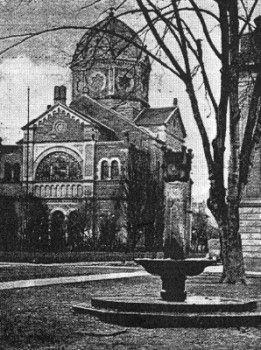
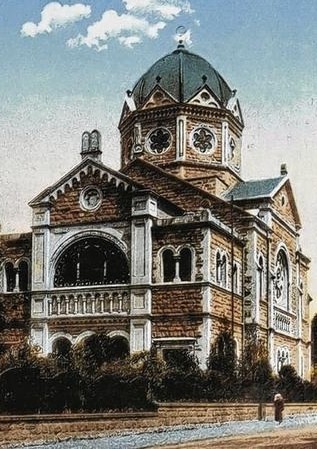

After Kristalnacht
The story is that the gentile caretaker of the Bad Kissingen synagogue - Mr. Hugo Albert, by name, very well spoken of by both current residents of Bad Kissingen[1] and decedents of Jews who lived there in the 30's - saved the parochet and other artifacts (among them a bimah cover and a sefer Torah, which is currently on loan, by the Oppenheimer family, to the USS Ronald Reagan):
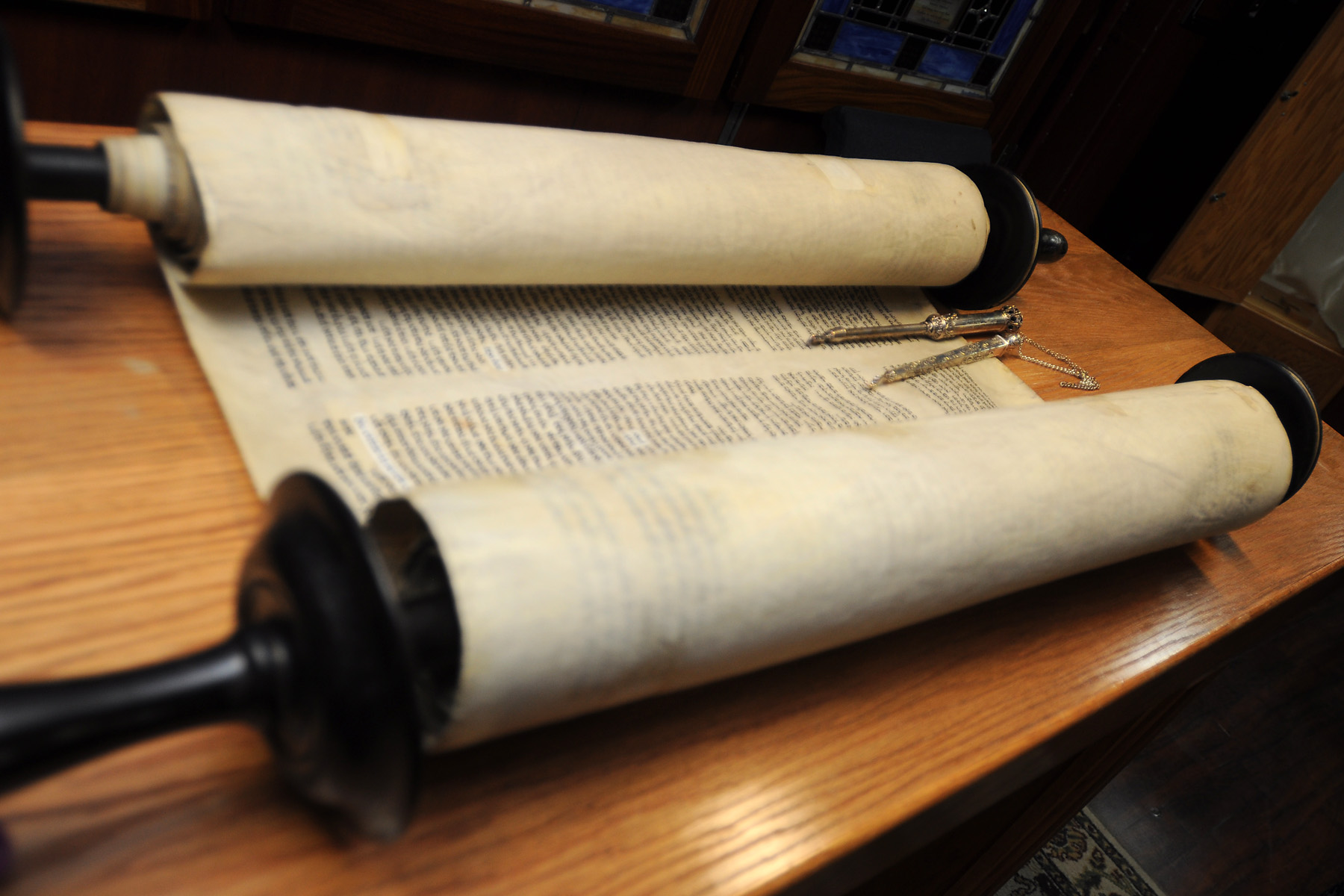
The 18th century sefer Torah of Bad
Kissingen, photo by Darrel Wesley, Command Chaplain, USS Ronald Reagan[2]
It appears that this sefer was given to the Hollander family shortly before Krystalnacht (November 1938). So far as I know, it is the only sefer that survived the burning of the synagogue. Fred Hollander escaped nazi Germany in 1938, bring the Torah out with him in a crate. It was used in synagogues in Chicago and then Cleveland. R. Oppenheimer (see below) is the stepson of Fred Hollander and arranged the donation of the sefer Torah to the Reagan. (http://articles.dailypress.com/2003-11-21/news/0311210122_1_numbers-and-deuteronomy-torah-sefer-scroll)
More links about this sefer Torah: aboard the Reagan
http://www.freerepublic.com/focus/f-news/1034098/posts
https://groups.google.com/forum/?fromgroups#!topic/soc.culture.jewish/zSMvBkiUVCEalso see:
https://www.google.com/search?q=bad+kissingen+parochet&tbm=isch&source=iu&ictx=1&fir=yKC4vM0_gi4-DM%253A%252C76FxDWBzjBRzyM%252C_&usg=AI4_-kToMDzhYX0JI-ru4kn1IELddVoKRA&sa=X&ved=2ahUKEwiZ25ve8vnfAhVSxVkKHRJJAw4Q9QEwA3oECAYQBA#imgrc=PiY8IoS4wKhHFM:
and
https://www.navy.mil/ah_online/ftrStory.asp?id=82625
According to the latest information given to me, the Ries family, now of Chicago, were Kissingers. Like the sefer Torah, they were given the parochet and Max Ries brought it out of Germany (a family member says that Mr. Albert gave the parochet to "Uncle Max" but it is more likely that the congregation entrusted the parochet to him, like the sefer Torah was entrusted the the Hollanders, on the courageous information of Mr. Albert). They later donated it to Temple Ezra in Chicago's Lakeview neighborhood. Temple Ezra merged with Congregation Ha'Bonim (in Chicago's Southshore community) in 1973, forming the Ezra Ha'bonim Synagogue, a conservative congregation, in the East Rogers Park neighborhood of Chicago (in September 1997, Congregation Ezra Ha'Bonim merged with The Niles Township Jewish Center, a Reconstructionist congregation, forming the current Ezra Ha'Bonim-The Niles Township Jewish Center; the parochet is current displayed at EHNTJC). Apparently a member of the Ries family flew to Europe specially to retrieve the parochet.
I recently was contact by the grandson of Gustav Neustaeder, the [last] shamash/hazan/shochet of the Bad Kissingen synagogue. Mr. David Neustaedter (son of Jack Neustaeder, son of Gustav and Paula (nee Bacharach) Neustaeder) is able to provide additional information. He writes:
|
My grandfather was the shamash and the cantor of the synagogue until it was destroyed and he was deported to the death camps.... The caretaker and his family lived on the third floor of the Gemeindehaus (Community house) that was adjacent to the synagogue. My grandfather lived on the first floor and the Steinberger family (of Nobel Prize fame) lived on the second. I have been in touch with the caretaker's son who I believe lives in California or Arizona. The caretaker got a lot of trouble because he didn't side with the Nazis and tried to protect some of the synagogue material. My [grandfather] was the shochet as well as the Hazzan and Shamash in the synagogue. He, his wife and youngest son were deported to the death camps. My father was sent much earlier to Switzerland [i.e., he was a kindertransport] where he stayed until the end of the war. I believe my father's first cousin, Jack Heimann, is a member of the synagogue you mention. He told me about the parochet, but I wasn't sure where it was. |
Further research indicates that Mr. Albert warned community officials of nazi intentions regarding the synagogue (and, it may be inferred, the Jewish community, see Encyclopaedia of Jewish Communities: Bad Kissingen).
About the Parochet and the Bad Kissingen synogogue, Hans-Jürgen Beck (who teaches in the Jack-Steinberger-Gymnasium in Bad Kissingen) provided the following from Theo Harburger's "Die Inventarisation jüdischer Kunst- und Kulturdenkmäler in Bayern":
| Die Thorarollen, die noch vor dem Brand aus der Synagoge in das Gemeindehaus gebracht worden waren, wurden dort unter amtlichem Verschluss gehalten. Sie konnten jedoch
von Gemeindemitgliedern durch Bestechung des Aufsehers gegen unbrauchbar gewordene Rollen ausgetauscht werden. Auch der wertvolle Thoravorhang von 1745, ein Thoraschild
von 1769, Thoraaufsätze und ein kupferner Chanukkaleuchter konnten auf diesem Wege gerettet werden. Im Betsaal des Gemeindehauses wurden die gesamte Inneneinrichtung und
die dort aufbewahrten Ritualien zerstört, unter ihnen Ritualgegenstände, die einen Monat zuvor aus der jüdischen Gemeinde von Willmars nach Kissingen gebracht worden
waren. Ein Teil der beschlagnahmten Kultgegenstände wurde 1941 dem Luitpoldmuseum in Würzburg übergeben, ein anderer Teil wurde versteigert, der Gesamterlös von 1547
Reichsmark bei der Gestapo hinterlegt. Zu den geretteten Judaica gehören neben den beiden in Bad Kissingen verbliebenen Thoravorhängen aus dem 19. und frühen 20. Jh. und der Bimadecke von 1886 ein Thoravorhang und eine Thorarolle aus dem 18. Jahrhundert. Der Thoravorhang, der sich heute in einer Synagoge in Chicago befindet, stammt aus dem Jahr 1745. Er wurde von dem Kissinger Juden Jehuda Mosche, dem Sohn des Josef, und dessen Frau Esther gestiftet. In der Mitte des wertvollen Thoravorhangs halten zwei Greife eine Krone, Symbol der Thora, rechts und links davon sind zwei Säulen mit Blumenvasen zu sehen. Auf dem Kaporet, der Schabracke des Thoravorhangs, erkennt man von rechts nach links einen goldenen Leuchter, ein Wassergefäß, die Bundeslade mit Lade, Räucheraltar und Schaubroten, darüber zwei Flügel mit einer Krone. Die Thorarolle wurde um 1700 in Kissingen geschrieben und 1882 restauriert. Da zur Entstehungszeit das Schächten in Kissingen verboten war, mussten die Kissinger Juden die Kühe heimlich schlachten und deren Häute gemäß den strengen Bestimmungen für die Herstellung von Thora-Pergamenten bearbeiten. So wurde die Thorarolle Sinnbild für die Unterdrückung durch die nichtjüdische Umwelt und zugleich sichtbarer Ausdruck des Überlebenswillens und des Traditionsbewusstseins der Kissinger Juden. Einige Zeit vor der Pogromnacht 1938 wurde die Thorarolle, die gut 250 Jahre in der Kissinger Gemeinde im Gebrauch war, Manfred Holländer übergeben, damit er sie in Sicherheit brächte. Heute befindet sie sich in der Synagoge an Bord des Flugzeugträgers USS Ronald Reagan, dem größten Schiff der Welt. Die Nachkommen Manfred Holländers hatten im Jahre 2002 dem Flugzeugträger die barocke Thorarolle für 50 Jahre zur Verfügung gestellt. |
The Torah
scrolls that had been brought out of the synagogue into the village
hall, were held there under official seal. By bribing the custodians,
however, community members were able to substitute scrolls that had
become unusable. The precious Torah parochet/curtain of 1745, a Torah
breastplate from 1769, Torah rimonim, and a copper Hannukah candelabrum
were also saved the same way. Destroyed in the prayer room of the
community hall were the entire interior furnishings and the ritual items
kept there for safekeeping; among them were ritual objects from the
Jewish community of Willmars that had been brought to Kissingen a month
earlier. A portion of the of the confiscated religious objects was
surrendered to the Luitpold Museum in Wurzburg, another portion was
auctioned off, with the entire proceeds of RM 1,547 deposited with the
Gestapo.
Counted among the saved Judaic items—in addition to both of the Torah parochets/curtains from the 19th- and early 20th-Century that were abandoned in Bad Kissingen, and the Bimah cover from 1886—are a Torah parochet/curtain and a Torah scroll from the 18th Century. The Torah parochet/curtain that can now be found in a Chicago Synagogue stems from the year 1745. It was donated by the Kissingen Jew Jehuda Mosche, the son of Josef, and his wife, Esther. In the center of the precious Torah parochet/curtain, two griffins hold a crown, symbol of the Torah, and to the right and left of them are two pillars with flower vases. On the Kaporet, on the valance of the Torah parochet/curtain, one can see, from left to right, a golden candelabrum, a water pitcher, the Ark of the Covenant with chest, sacrificial altar and showbread (lechem panim), and above them two wings with a crown. The Torah scroll was written around 1700 in Kissingen and was restored in 1882. Because at the time of the making of these Torah scrolls kosher butchering was forbidden in Kissingen, the Kissingen Jews had to slaughter the cows secretly and process their hides in strict conformance with the rules for the production of Torah parchment. Thus did the Torah scroll become the symbol for the oppression by the non-Jewish environment and at the same time a visible sign of Kissingen Jews’ will to survive and fidelity to tradition. Sometime before Kristallnacht of 1938 the Torah scroll was delivered to Manfred Hollaender—it had been a good 250 years in the possession of the Kissingen community—so that he would bring it to safety. Today it resides in the synagogue on board the aircraft carrier USS Ronald Reagan, the largest ship in the world. The descendants of Manfred Hollaender provided the baroque Torah scroll to the aircraft carrier for the next 50 years.
|

[1] I have this from Hans-Jürgen Beck (Hans-Jürgen Beck/Walter Rudolf: Jüdisches Leben in Bad Kissingen, publ. Stadt Bad Kissingen 1990, 220 pages)
[2] Commander Darrell Wesley, senior Chaplain aboard the USS Ronald Reagan (2013), with the sefer Torah and other pictures:
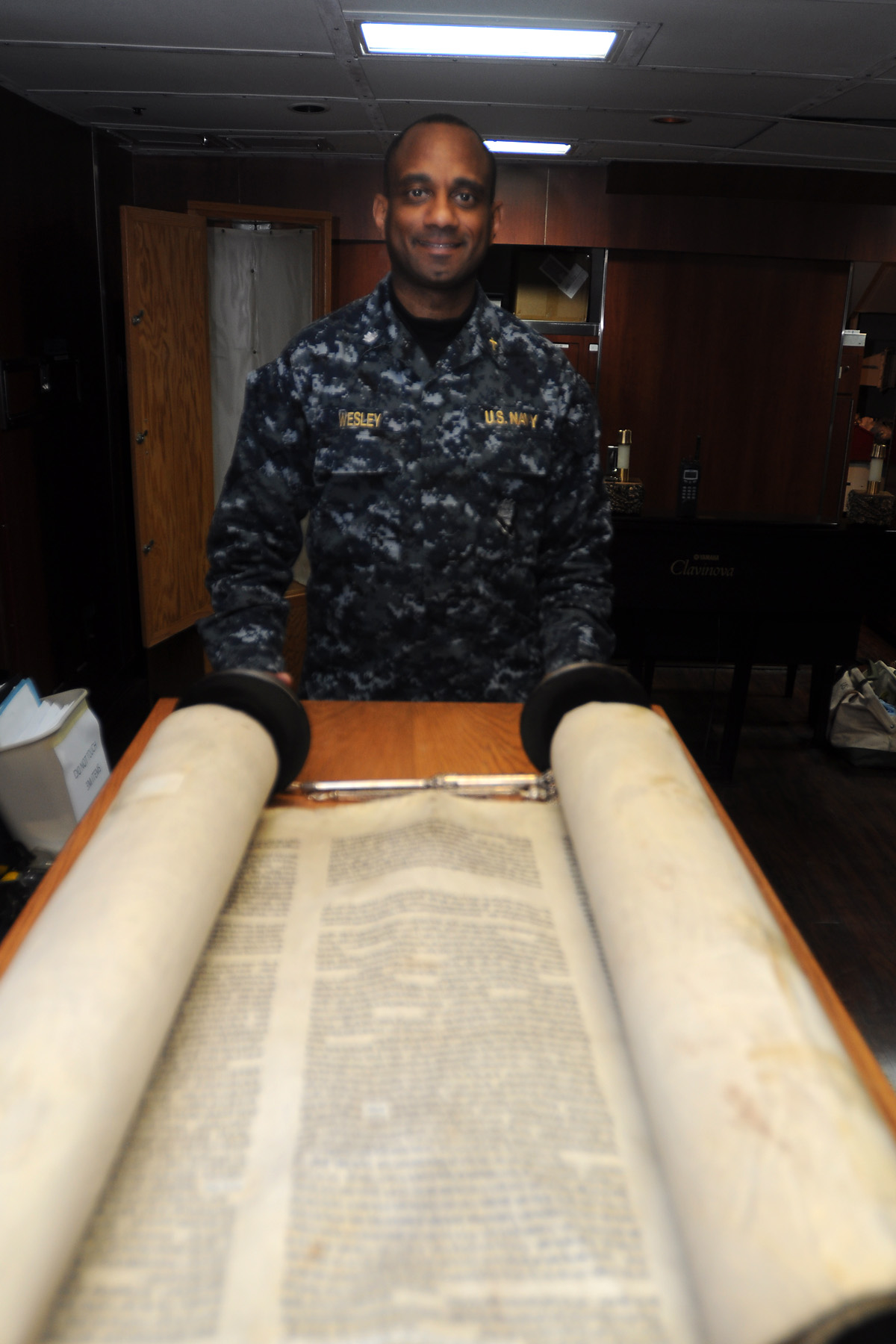 |
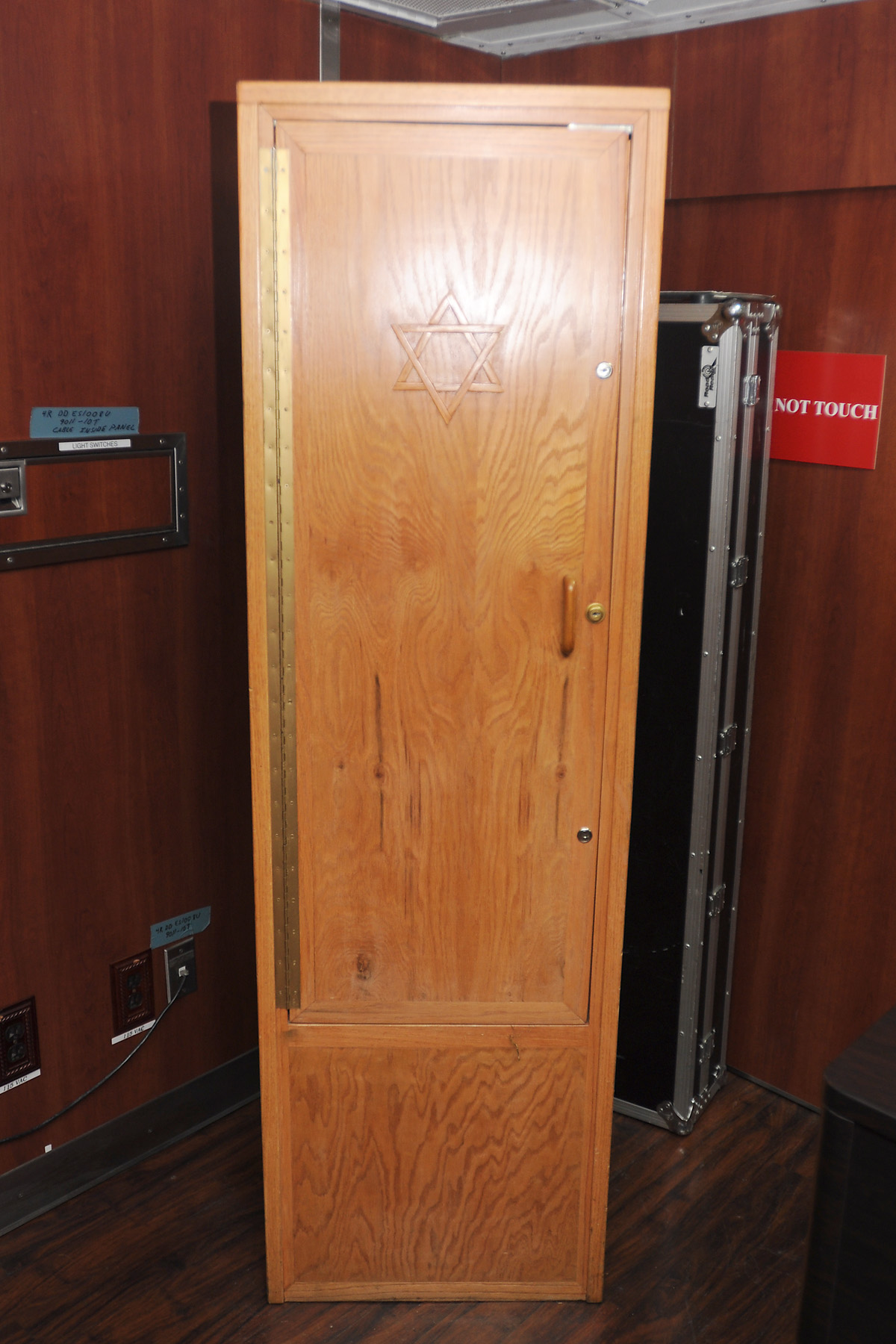 |
 |
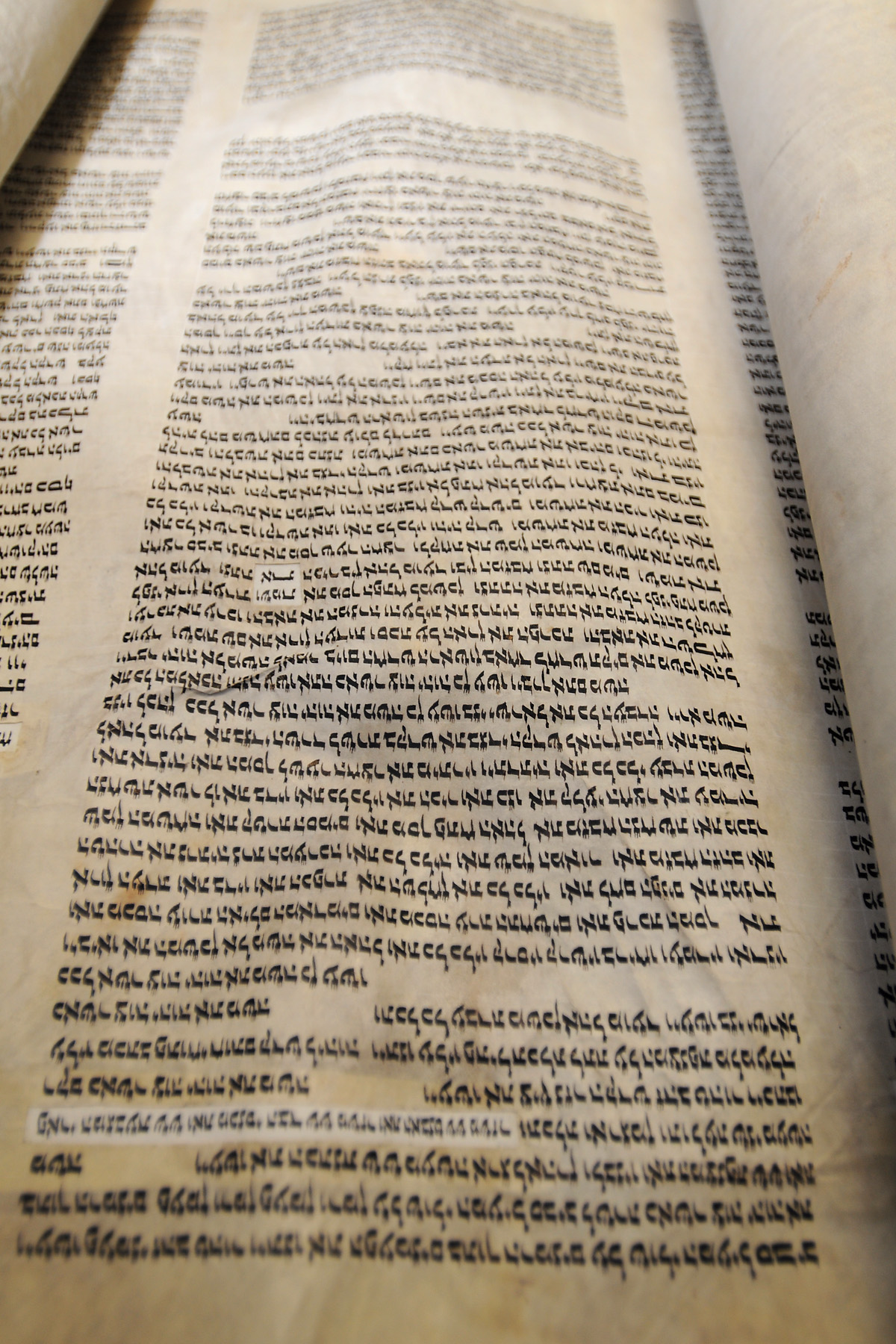 Note this is the end of Exodus / beginning of Leviticus and the two repairs to this klaf |
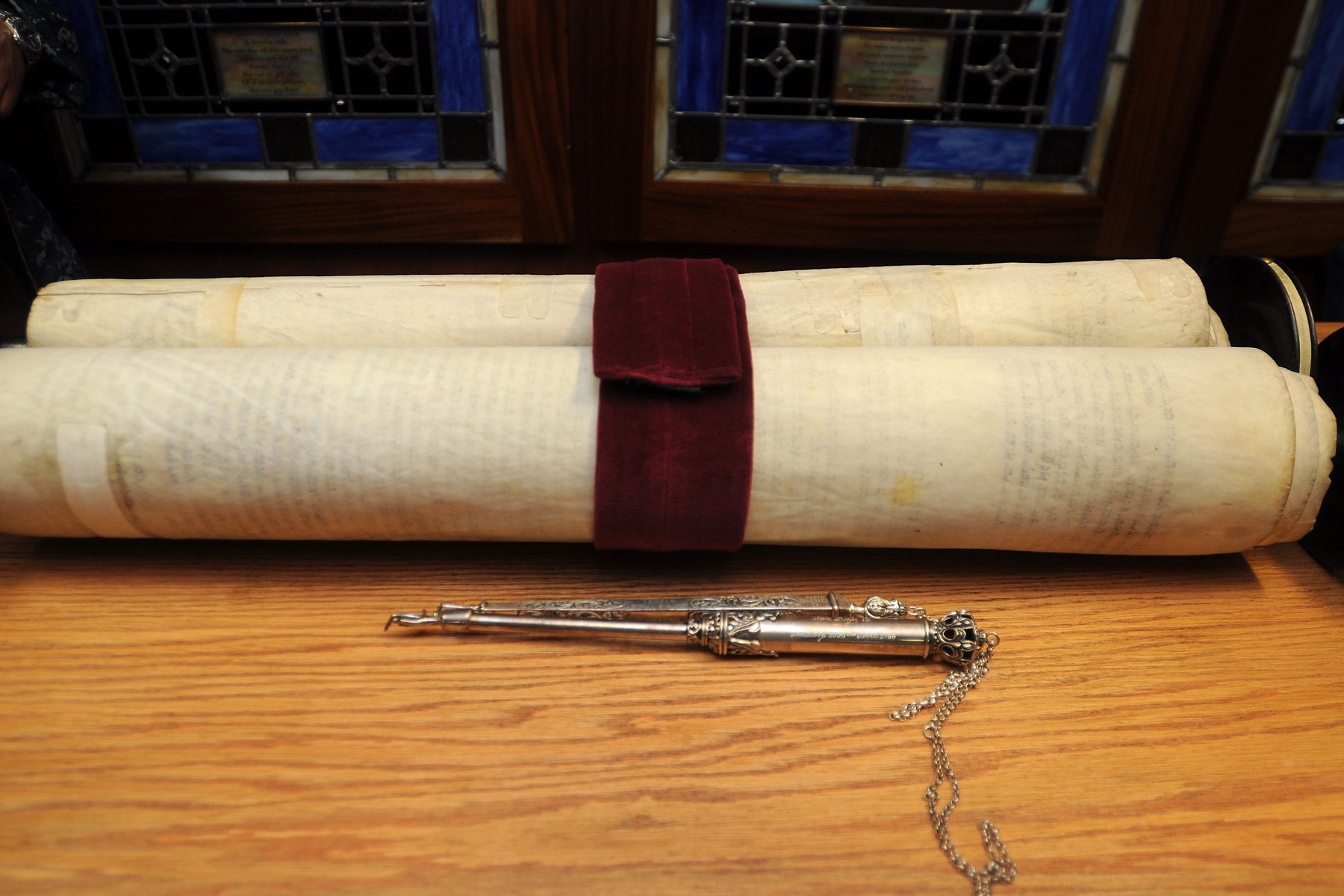 |
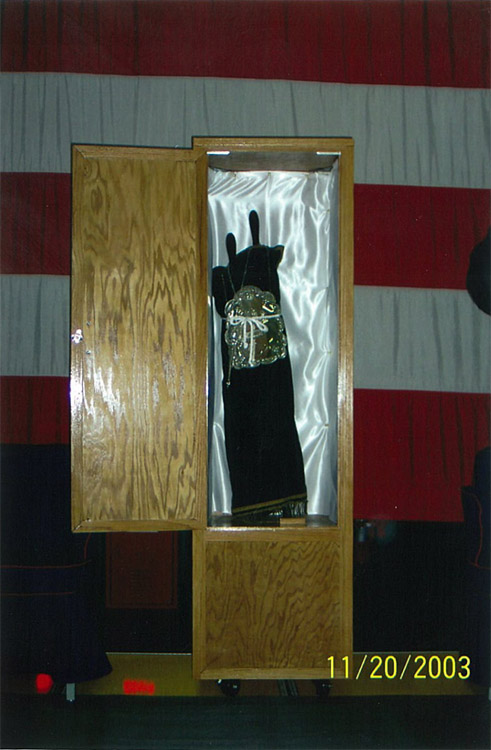 Photo from the dedication ceremony on USS Ronald Reagan |
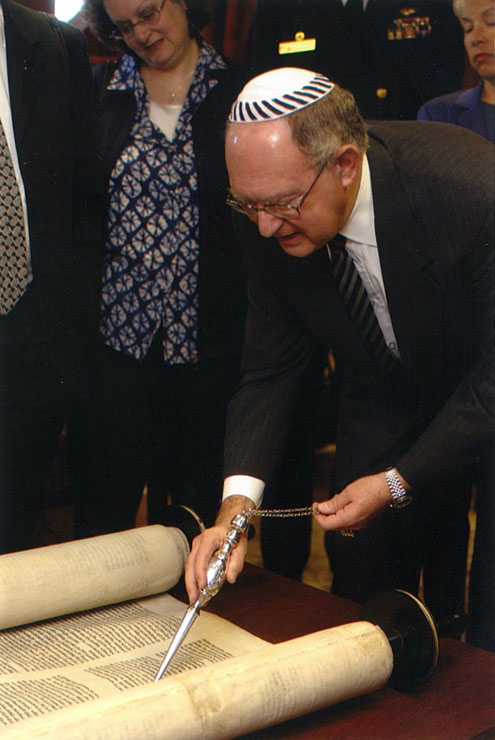 Rabbi Michael Oppenheimer, of the donating family, at the "dedication ceremony, " as the sefer Torah was installed on the Reagan |